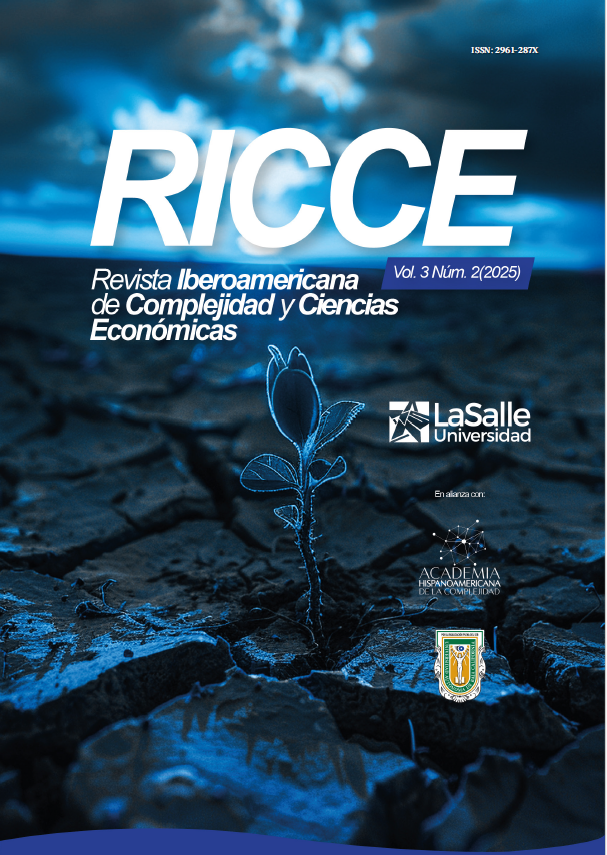MATHEMATICAL MODELING IN EDUCATION FOR UNDERSTANDING
Abstract
From the sciences of complexity, mathematical modeling in educational processes prioritizes emotional intelligence for understanding and self-esteem; recognizes instabilities, gaps, indeterminacies, and coevolutions; identifies emergent properties with autonomous structures such as "rhizomes" or "fractals," ruptures, fluctuations, and (de)constructions; reveals self-organizing uncertainties, between cognitive flexibility and plasticity, which contribute to learning for understanding.
Downloads
References
• Holling, C. 2011. Resilience and Stability of Ecological Systems, Annual Review of Ecology and Systematics.
• Jhonson, Steven; Los Sistemas Emergentes; Fondo de Cultura Económica, 2009.
• Kauffman, S. (2011). Information Processing and Biological Systems. Springer.
• Langton, C. G. (1990). Complex Systems Group, Los Alamos National Laboratory, Los Alamos.
• Langton, C. (1989). Artificial Life. In C. Langton (Ed.). Addison-Wesley.
• Landauer, R., (1991). “Information is physical” en Physics Today 4.
• Leff, Enrique (2009), Ecología, Capital e Cultura: a Territorialização da Racionalidade Ambiental. Editora, Petrópolis, Brasil.
• Lorenzón, E. E. (2020). Sistemas y organizaciones. Libros de Cátedra.
• Luhmann, N (1990). Sociedad y Sistemas: La ambición de la teoría, U.A. de Barcelona.
• Maldonado, Carlos (2021). Las Ciencias de la Complejidad son Ciencias de la vida. Trepen Ediciones, Chile.
• Maldonado, C. E., (2021). Biosemiótica y complejidad. Bogotá. Ed. Universidad El Bosque.
• Maldonado, Carlos y Gómez, Nelson (2018) El Mundo de las Ciencias de la Complejidad
• Maldonado, C. E. (2014). ¿Qué es eso de pedagogía y educación en complejidad? Debate Teórico-Metodológico.
• Maturana, H. y Varela F. (2003). El árbol del conocimiento. Lumen, Buenos Aires
• Mandelbrot, B. (2004). Fractals and Chaos: The Mandelbrot Set and Beyond, Springer Verlag N.Y
• Martyushev, Leonid M. 2023. Old Misconceptions and New Breakthroughs, Entropy Production, Entropy.
• Mason, M. (2008). Complex theory and the Philosophy of education. Wiley-Blakwell
• Méndez I. E. Carvajal B.M. (2029). Una mirada a los fundamentos biológicos de la educación desde la teoría de Santiago. Universidad de Camagüey, Cuba Mitchell. M. (2012). Biological computation. The Computer Journal, 55(7), 852-855.
• Montealegre, M. (2013). Matemáticas para la creatividad del I al V, Tiempos Ecológicos, Colombia.
• Montealegre M. y Vera J. (2022). Hacia la Pedagogía de la Complejidad. Revista Ciencias de la Complejidad.
• Montealegre, M. Montealegre J. y Vera J. (2024). Modelado de la sostenibilidad Ambiental, MAPI3.
• Morin, E. (2005). Los siete saberes necesarios para la educación del futuro UNESCO, 2018.
• Newman, M. (2003). The structure and function of complex networks. SIAM review.
• Neumann, J.V. (1966) Theory of Self-Reproducing Automata, Illinois University Press.
• Nicolis G. and I. Prigogine (1989). Exploring Complexity. W H Freeman & Co
• Nowak M.A. (2006). Evolutionary Dynamics, explorando la ecuación de la vida.
• Pagels, H. (1991). Los Sueños de la Razón: El Ordenador y los Nuevos Horizontes de las Ciencias de la Complejidad. Barcelona: Gedisa.
• Perkins, D. et.al. (2014). Hacer visible el pensamiento. Paidós.
• Perkins, D. (2017). Educar para lo desconocido, Ediciones SM, Madrid
• Piaget J. y García R.(1982) Psicogénesis e Historia de la Ciencia, Siglo XXI.
• Piaget, J. y Vygotski, L. (1996). Biología y conocimiento.
AcademiaPierce, C. (2008). Pragmatismo. Ediciones Encuentros, Madrid.
• Prigogine, I. (1998). El fin de las certidumbres, Andrés Bello. Andrés Bello, Chile.
• Piaget, J (1982). Epistemología Genética. Editorial Debate, Brasil.
• Ruelle, D. (2023). A Review of differentiable dynamical systems, IHES France
• Resnick, Mitchel (2001). Tortugas, Termitas y Atascos de Tráfico.
• Reyes Gómez, D. A. ( 2011). Descripción y aplicaciones de los autómatas celulares. Harvard University Press.
• Reynoso, C. (2009); Redes y complejidad: modelos y algoritmos no convencionales en investigación sociocultural
• Rodriguez Zoya, L., & Pascal , R. (2015). Modelos basados en agentes. Revista Mexicana de Ciencias Políticas y Sociales.
• Sipper, M. (1990). The emergence of cellular computing. IEEE Computer, 32(7).
• Shannon, C. y Weaver, W. (1949). The Mathematical Theory of Communication. University Illinois Press.
• Smith E. y Morowitz H.(2016). The Origin and Nature of Life on Earth, Cambridge University Press.
• Tall, D. (1996). Advanced Mathematical Thinking Computer. Education Warwick.
• Thom, R. (1983). Mathematical models of morphogenesis. Ellis Island .
• Turing, A. (1950). Computing Machinery and Intelligence. Mind 49: 433-460
Copyright (c) 2025 Iberoamerican Journal of Complexity and Economics Sciences

This work is licensed under a Creative Commons Attribution-NonCommercial-NoDerivatives 4.0 International License.
The authors transfer exclusively the right to publish their article to the Iberoamerican Journal of Complexity and Economics Sciences, which may formally edit or modify the approved text to comply with its own editorial regulations and with universal grammatical standards, before its publication; Likewise, our journal may translate the approved manuscripts into as many languages as it deems necessary and disseminate them in various countries, always giving public recognition to the author or authors of the research.









